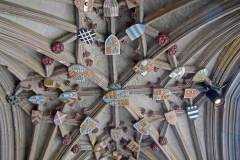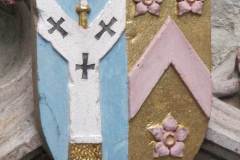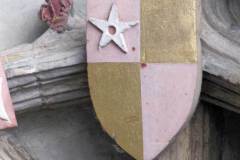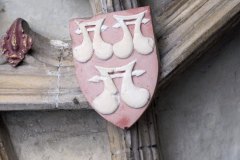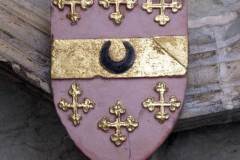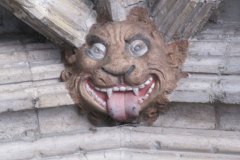The 29 heraldic shields on the ceiling of the south west porch represent individuals, institutions and families associated with the construction of the porch. It was finished around 1425, possibly intended to commemorate the English victory at Agincourt in 1415. They provide accessible examples of several important aspects of English heraldry, particularly since they are well restored and, in view of the low ceiling, readily visible. A few examples follow.
What to see:
- the 29 shields appear in the lierne vaulting of the porch (Image 1) – the large central boss shows the arms of Henry IV incorporating three golden lions of England and three fleurs-de-lis of France
- in the arms of Archbishop Chichele (Image 2) the pallium of the See of Canterbury on the left is ‘impaled’ on the arms of Chicheley – a chevron with three flowers (pierced cinqufoils in heraldic terms)
- in the arms of the Veres family (Image 3) note the five pointed star known as a pierced mullet, derived from the French term for the small wheel at the back of a knight’s spurs
- the odd shapes on the Roos arms (Image 4) are not pairs of musical notes but ‘bougets’ or water buckets; apart from being one of the earliest heraldic devices, this reflects the links between heraldry, the crusades, and warfare
- the shield of Richard Beauchamp (Image 5) includes six ‘crosselets’ and, within the middle band known as a fesse, a crescent moon; the latter forms part of the heraldic scheme of ‘cadency’ or distinguishing arms of the father from those of his offspring – the crescent indicates the second son
- floliate lion heads (Image 6)
Sources: see standard cathedral sources; also Griffin (1921)
DL

